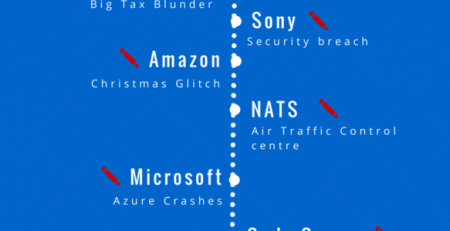The ‘Dreadpool’ of Software Testing Challenges
Customers across the globe are getting digital – online transactions, social media updates, new technology updates, and much more. While the empowerment happens, there are a lot of grey areas that need to get filled up to ensure compatibility, accessibility, and security of digital applications and interfaces. Likewise, Digital Transformation powered by Digital Technologies has resulted in major changes in software product development and testing methodologies. The year 2017 witnessed massive proliferation of digital technologies and adoption of new and innovative platforms.
The year 2018 is already witnessing newer technologies getting embedded, and testing and development team are struggling to bring down the complexities and stay innovative. There are a whole lot of unforeseen software testing challenges that teams will have to accommodate and resolve in the process.
With technologies such as Blockchain, Artificial Intelligence, Predictive Analytics, and Virtual Reality making strides, Quality Assurance and Software Testing will have to keep on reinventing.
New technologies and the growing need to accommodate new development methodologies will drive the growth for software testing in the coming year. These are some key dreading challenges that Software Quality Assurance and Testing is expected to face as businesses continue to climb up on the technology route.
Achieving enhanced Test Coverage
With growing complexities in the application, teams will have to ensure maximum Test Coverage. This will increase the use of Test Automation for bringing down the testing efforts and achieving better results. Every feature has to be tested to ensure that the ultimate experience is desirable and as expected. Any glitches in production will lead to business as well as reputation loss.
Teams will have to leverage automation tools and track the progress in detail to achieve enhanced test coverage. Will it ultimately help in bringing down the risks? Only experimentation and process discipline can ensure that.
Organizational Transformation, not just process adoption
Quality Assurance and Software Testing cannot work in silos. There will be a constant need for organizational acceptance of the new processes and for nurturing it at a macro level. Methodologies and approaches such as Agile, Shift-Left, and DevOps will need organizational acceptance before on-ground application of the protocols.
Hence, it will be business-critical for enterprises to involve every function within the system to participate in the Quality Transformation process. This will certainly emerge as a challenge for organizations, as it will require specific attention towards managing expectations and processes for involving the stakeholders. Nevertheless, this will pay off in the longer run.
Collaborate with Development teams
With changing dynamics within the development and testing space, developers and testers will have to collaborate much frequently. This can be a challenge, where there could be disputes and disagreements amongst them. Hence, a lot of skill-sets and work maturity will be needed to bridge the gap and work cohesively as a team. The testers will need excellent communication tactics and analytical skills to build the needed rapport.
Work under time and resource constraints
Organizations are moving towards intense competition, limited resources, and shorter timelines to build a lucrative business ecosystem. This will always leave the testing teams with strained timelines to catch up on their critical tasks. Testers will have to work with robust plans and tested tools that provide accurate results, and bring down the testing time and efforts. Automation will be needed for every activity, right from writing the tests, to execution and automation.
Early Defect Detection
The fresh trend in Software Development Lifecycle is to encourage early testing and early detection of defect to attend to issues/bugs. This need will intensify as the business scenario gets more and more challenging and competitive. Teams will have to come up with mechanisms to fix issues in real-time and do frequent review of codes to identify issues early in the lifecycle. A combination of static and dynamic tools will be needed to check for missing error routines, code standards, data type mismatch, and much more.
Nevertheless, the application of tools will have to be determined as per the project’s requirement. Testers are bound to face this challenge every time.
Effective API Testing
Every application or software today comes with a service oriented architecture (SOA) with APIs that are publicly exposed for extended use by developers. Most of the times API testing is ignored due to its complexity or lack of necessary skills. However, the need for API testing will increase due to the risks involved. Testing teams will have to work with tools to do the same and even develop strong coding skills.
Ensure repeated Performance
Software applications are getting more complex, which will put added pressure on ensuring that all the performance bottlenecks are covered. While this is a challenge, testers will have to increasingly ensure that the application or software delivers repeated performance under varying pressures and spikes in traffic. Load testing tools can be useful, but ensuring Performance will need robust strategy and result-oriented testing.
Documentation of the tests and results, and automation of the tests will help in validating results and cutting down the testing efforts as well.
Nurture testers for Agile and DevOps
Agile and DevOps will grow as a trend and testers will have to build their skills and strategies to fit in. Test Automation will be needed for frequent and repeated testing. Hence, for the sake of velocity, performance and agility, testing teams might have to reskill themselves. This can be a one-time activity, but will offer extended value in the software development and testing lifecycle.
The software and application scenario is getting highly competitive, and driving the need for gaining speed, accuracy, and precision. Quality Assurance and software Testing will have to redefine to deliver in such challenging scenarios. Continuous Testing, Continuous Development, and Continuous Integration is becoming a way of software development. There is no scope for any downtime with the software or application. These are challenges that will bring in opportunities for businesses.
Business models are being transformed as the world is riding the wave of digital. As enterprises look to be digital, they need best of the breed Quality Engineering services. Cigniti’s BlueSwan™ is a next generation Proprietary Testing platform. Aligning with the needs of the market in the digital era, BlueSwan also is Cigniti’s enabler towards being the leader in independent software testing services.
Connect with our Quality Assurance and Testing experts to fortify your business strategies and achieve your long term organizational goals.





Leave a Reply